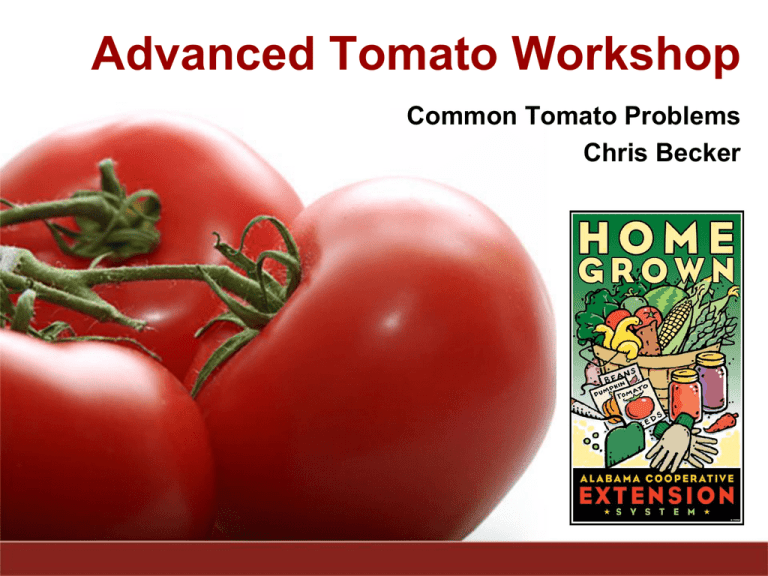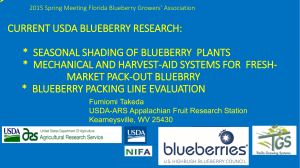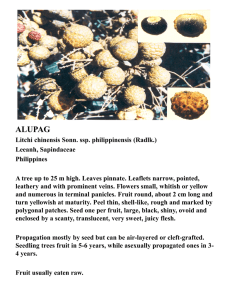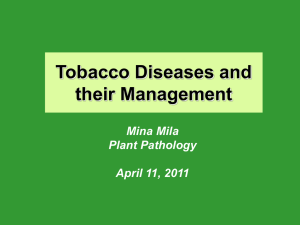Advanced Tomato Workshop
advertisement

Advanced Tomato Workshop Common Tomato Problems Chris Becker Tomato Problem Quiz Answers Insect, Disease, or Disorder? What is a Disease? • A plant disease is usually defined as abnormal growth and/or dysfunction of a plant. Diseases are the result of some disturbance in the normal life process of the plant • Diseases may be the result of living and/or non-living causes. Diseases Abiotic • Abiotic diseases are caused by non-living environmental conditions such as frost, hail, and chemical burn, nutrient deficiencies. Biotic • Biotic diseases are caused by living organisms. • Biotic causes of disease include fungi, bacteria, viruses, phytoplasmas, nematodes, and parasitic plants. Disease Symptoms Symptoms of disease are the plant’s reaction to the causal agent. • • • • • • • • • Blight – A rapid discoloration and death of twigs, foliage, or flowers. Canker – Dead area on bark or stem, often sunken or raised. Chlorosis – yellowing – Chlorosis is so generic that without additional details diagnosis is impossible. Decline – Progressive decrease in plant vigor. Dieback – Progressive death of shoot, branch or root starting at the tip. Distortion – malformed plant tissue. Gall or gall-like – Abnormal localized swelling or enlargement of plant part. It could be caused by insects, mites, diseases, or abiotic disorders. Gummosis – Exudation of gum or sap. Leaf distortion – The leaf could be twisted, cupped, rolled, or otherwise deformed. • • • • • • • • Leaf scorch – Burning along the leaf margin and into the leaf from the margin. Leaf spot – A spot or lesion on the leaf. Mosaic – varying patterns of light and dark plant tissue. Necrosis – dead tissue – Necrotic areas are also so generic that without additional details diagnosis is impossible. Stunting – lack of growth. Wilt – General wilting of the plant or plant part. Witches broom – Abnormal broom-like growth of many weak shoots. Insect feeding injury is also a symptom used in diagnosis, but not a symptom of disease. Disease Signs Signs are the actual organisms causing the disease. • • • • • Conks – woody reproductive structures of fungi. Fruiting bodies – Reproductive structures of fungi; could be in the form of mushrooms, puffballs, pycnidia, rusts, or conks. Mildew – whitish growth produced by fungi composed of mycelium. Mushrooms – fleshy reproductive structures of fungi. Mycelium – thread-like vegetative growth of fungi. • • • • Rhizomorphs – Shoestring-like fungal threads found under the bark of stressed and dying trees caused by the Armillaria fungi. They may glow in the dark! Slime Flux or Ooze – A bacterial discharge that oozes out of the plant tissues, may be gooey or a dried mass. Spore masses – masses of spores, the “seeds” of a fungus. Insects and/or their frass (excrement) are also signs, although not signs of disease. #1 Aphids Insect Pests Have piercing, sucking mouthparts; physical damage not always apparent Usually found on underside of leaf They can reproduce asexually. Color varies in species Produce honeydew Prevention Insecticides #2 Fruit Cracking/Splitting An Environmental Disorder Caused by rapid fruit development and wide fluctuations in water availability to the plant. Mature ripening fruit are most susceptible, especially when there is a very dry period followed by heavy rainfall. Severity varies greatly by variety. Prevention incorporate organic matter, use drip irrigation, apply mulch #3 Septoria Leaf Blight A Fungal Disease Causes numerous small ( about 1/8" to 1/4" in diameter) brown spots that develop light tan to white center as they age Similar to early blight. Attacks older leaves – turns yellow, brown, then withers and dies. Wet humid conditions favor the development . It usually appears after plants begin to set fruit. Prevention use mulch, apply fungicide, limit wetting foliage / overhead watering #4 Herbicide Damage Herbicide Damage Symptoms include downward rolling of leaves and twisted growth. In addition, stems may turn white and split; fruit may be deformed. Depending on the level of exposure, the plant may or may not survive. Prevention Do not apply 2-4-D like herbicides near the garden Avoid drift Prevent contamination by keeping herbicide spray tanks separate from insecticide & fungicide spray tanks. #5 Glyphosate Injury Herbicide Damage White/Yellow discoloration at the base of the youngest leaflets. A result of spray drift to the stem of the plant and/or application during a windy day. Herbicide on stem becomes translocated to the upper leaves. 1/50th to 1/150th rate can do this type of damage. Prevention Use a shield to limit drift. Cut off the leaves and observe the plant #6 Southern Blight A Soilborne Fungal Disease Causes yellowing of leaves and wilting of infected plants. The stem at the soil line appears soft and sunken (cankered) and turns brown to black. Under moist conditions, a white fungal growth occurs on the lower stem near the soil surface. Favored by moist conditions and high temperatures above 85 °F. Prevention crop rotation, soil solarization, deep plowing #7 Fusarium Wilt A Soilborne Fungal Disease Invades the roots, plugs-up the water conducting vessels, causes yellowing and wilting of leaves. Initially causes a yellowing and wilting of lower leaves on a single branch. Whole plant eventually wilts and dies. Prevention use resistant varieties, crop rotation, soil solarization. #8 No Tomatoes Mostly an Environmental Disorder Plants sometimes drop their flowers when night temperatures are lower than 55°F. When night temperatures above 70°F, flower production and pollination are reduced. Favorable night range for tomato fruit set is between 58 and 68°F. Very hot daytime temperatures coupled with drought is a cause too. May occur due to excessive nitrogen. Prevention Use heat resistant varieties. #9 Tomato Fruitworm Insect Pest Also known as Corn Earworm Caterpillar color varies from light green to reddish-brown. Usually has a broad dark stripe with a light stripe on the body. Feeds on stem end, entering inside the fruit of green tomatoes. Feeding damage leads to watery and wormy fruit. Prevention Hand Remove Insecticides #10 Blossom End-Rot A Nutrient Disorder Caused by a Calcium Deficiency, Due to improper soil pH, above or below 6 - 6.5. Insufficient calcium in soil Aggravated by changes in soil moisture – too dry or too wet Prevention spray calcium nitrate for temporary relief, take a soil test, add lime, keep soil moisture consistent. #11 Catfacing A Physiological Disorder Misshapen ugly fruit. Cold weather at the time of blossom set distorts and kills certain cells that should develop into fruit, resulting in the deformities. Most often observed among firstformed fruit. Common in the large-fruited “beefsteak” type tomatoes. Prevention none #12 Zippering A Physiological Disorder A thin longitudinal scar from the stem scar to the blossom end. Series of transverse scars which resemble a zipper. This defect happens when the flower anthers fuse to the ovary wall of developing fruit Occurs most commonly when fruit set takes place in cool weather. Varieties can vary in their susceptibility to this malady. Prevention None #13 Stinkbugs An Insect Pest Feed with piercing-sucking mouthparts which cause whitishyellow corky spots underneath the skin of the fruit. On green fruit, damage appears as dark pinpricks surrounded by a light discolored area Commercially, this damage is serious because they render the fruit unmarketable. Prevention Insecticides #14 Early Blight A Fungal Disease Begins on older lowers leaves by turning them yellow. Leads to irregular spots that enlarge to ½ inch in diameter with concentric rings and a yellow halo. Plants appear to “fire-up” from their base Early season pest; warm, wet weather favor its development Prevention use mulch, apply fungicide, limit wetting foliage / overhead watering #15 Tomato Spotted Wilt Virus Virus disease spread by thrips Infected plants are stunted, may die slowly. Dark ring spots form on leaves. Terminal leaves stop growing, become distorted and have a pale purple/bronze appearance. Fruit exhibit “real cool-looking” ringspots. Prevention Remove suspected and infected plants immediately, control insects, use resistant varieties #16 Armyworms Insect Pest Caterpillar color varies from dull green to black. Older larvae have a broad, lightcolored stripe along the side of the body. Feeds primarily on leaves but will attack fruit making a single or group of holes or depressions. Damage is typically superficial but could lead to fruit to rot. Prevention Hand Remove Insecticides #17 Leaf Roll A Physiological Disorder Edges of the leaves roll upward and inward. High temperatures, prolonged periods of wet soil conditions, and drought may promote symptom development. Symptoms are most common when plants have a heavy fruit set. Associated with varieties having a specific gene that favors this condition. Prevention Variety Selection, Irrigation #18 Cutworms An Insect Pest Active only at night and remain buried below the soil surface near food plants during the day. They emerge to feed at night and often cut seedlings or small stems, causing the plants to fall over. Prevention Insecticides, remove grass and weeds, plow the soil well in advance of planting, use paper or plastic "sleeve" over the plant to protect the stem. #19 Sunscald A Physiological Disorder Initial symptom is a whitish, shiny area that appears blistered. Occurs on green tomato fruit exposed to the sun. Injury is more serious during periods of abnormally high temperatures. The killed tissue is quickly invaded by secondary organisms and the fruit decays. Prevention Control foliar diseases Avoid heavy pruning #20 Bacterial Spot and Speck Bacterial Diseases Introduced on transplants Attacks leaves and fruit Favored by warm, wet conditions Leaf spots can be irregular and ragged Fruit spots can be raised or scabby Prevention Use disease-free transplants #21 Tobacco Hornworm Insect Pest Large, smooth, green caterpillar of the Carolina Sphinx moth. Mature larvae measure 3½” in length Has seven or eight conspicuous white V-shaped markings down each side and a prominent spike (horn) on its rear end Feeds on the leaves, stems and fruit of tomato plants Prevention Hand remove, insecticides, plant dill a trap crop. #22 Adventitious Roots A Physiological Disorder These are adventitious roots or aerial roots which would grow into normal roots if placed in contact with the soil. They emerge as a result of stress, particularly water-related stress. Determined by cultivar, weather conditions and culture. Prevention Maintain moisture, mound compost around root initials on the lower part of the plant. #23 Thrips Tiny Insect Pests Prefer to feed in flowers, but also occur in flower and leaf buds and on leaves. Feeding on foliage may cause a bronzing or silvering of foliage. Eggs inserted in fruit causes dimpling, and the infested area may appear white. Thrips are also vectors of tomato spotted wilt virus. Prevention Insecticides #24 Whiteflies An Insect Pest Adults are very small, white and moth-like; 1/16th inch long. Feed underside the leaves on plant sap. Usually noticed during mid to late summer. Numbers are usually not sufficient to cause damage to plants. They do excrete honeydew and may cause sooty mold. Prevention Insecticides, sticky traps #25 Spidermites An Arachnid Pest They damage plants by inserting their stylet mouthparts into individual plant cells and withdrawing cellular liquids and contents. Damaged plants take on a bronzed appearance. Affected leaves eventually die and turn brown. Tends to be hot weather pest. Prevention Horticultural oils and soaps #26 Bacterial Wilt A Soilborne Bacteria Disease Most commonly found in low, wet areas of fields. Plants wilt and die rapidly without yellowing or spotting of the foliage. It invades and gradually blocks the vascular tissue (the food- and water-conducting vessels just beneath the epidermis). The pith will turn brown and sometimes become hollow. Prevention crop rotation, soil solarization. #27 Nematodes Microscopic wormlike animals found in the soil – 1 mm in length. Damage plants by feeding on roots, impairing its ability to take up water and nutrients. Cause stunting, leaf yellowing, loss of plant vigor, reduction in yields, and wilting. Causes distinct swellings or galls on roots. Non-uniform distribution of symptomatic plants Prevention Soil Solarization, Crop Rotation #28 Flea Beetle Flea beetles are tiny black beetles that jump when disturbed. Overwinter as adults and begin feeding in spring. Feed on the undersides of leaves causing small holes or sunken pits. Mostly a problem on new seedlings, and if left unchecked, can cause significant Prevention Insecticides #29 Leaf-footed bug Insect pest that feeds on tomato plants during the adult and nymph stage. Overwinter as adults and begin feeding in spring. Congregate and feed together during nymph stages. Prevention Insecticides #30 Buckeye Rot Caused by the fungus phytophthora parasitica. Starts as a grayish green or brown spot on fruit that has come into contact with soil. Light and dark brown concentric bands appear in the affected area. This firm, leathery rot is characterized by a smooth surface and lack of sharply defined margins. Prevention Mulch, prevent fruit from touching the soil.







